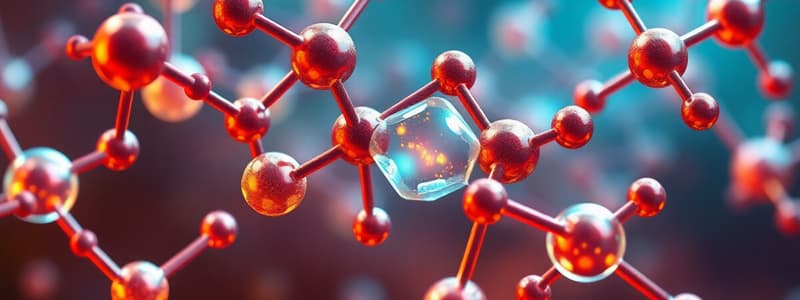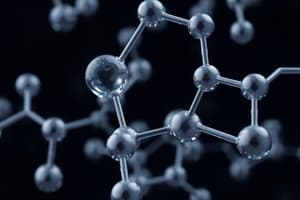Podcast
Questions and Answers
Which of the following lipids is composed of two fatty acids, glycerol, and a phosphate group?
Which of the following lipids is composed of two fatty acids, glycerol, and a phosphate group?
- Triglycerides
- Saturated fats
- Phospholipids (correct)
- Steroids
Triglycerides are made up of a glycerol molecule and two fatty acids.
Triglycerides are made up of a glycerol molecule and two fatty acids.
False (B)
Name a type of lipid that has a core structure of four carbon rings.
Name a type of lipid that has a core structure of four carbon rings.
Steroids
The material forming the outer membrane of cells is largely composed of __________.
The material forming the outer membrane of cells is largely composed of __________.
Match the following lipids with their characteristics:
Match the following lipids with their characteristics:
What are the 'rails' of the DNA double helix primarily composed of?
What are the 'rails' of the DNA double helix primarily composed of?
RNA stands for ribonucleic acid.
RNA stands for ribonucleic acid.
What is the function of DNA in living organisms?
What is the function of DNA in living organisms?
RNA helps transport information from DNA to the sites of ______________.
RNA helps transport information from DNA to the sites of ______________.
Match the following components with their functions:
Match the following components with their functions:
What are carbohydrates primarily formed from?
What are carbohydrates primarily formed from?
Glycogen is the primary nutrient storage form of carbohydrates in plants.
Glycogen is the primary nutrient storage form of carbohydrates in plants.
Name one polysaccharide that serves structural functions in organisms.
Name one polysaccharide that serves structural functions in organisms.
Chitin forms the _____ skeleton of arthropods.
Chitin forms the _____ skeleton of arthropods.
Match the following complex carbohydrates with their functions:
Match the following complex carbohydrates with their functions:
Which of the following is NOT a polysaccharide mentioned in the content?
Which of the following is NOT a polysaccharide mentioned in the content?
All lipids share a common structural element.
All lipids share a common structural element.
What is the defining characteristic of lipids?
What is the defining characteristic of lipids?
Why is carbon considered a central element to life?
Why is carbon considered a central element to life?
Carbon has eight electrons in its outer shell.
Carbon has eight electrons in its outer shell.
What effect do functional groups have on carbon-based molecules?
What effect do functional groups have on carbon-based molecules?
Adding an –OH group to a hydrocarbon results in the formation of an __________.
Adding an –OH group to a hydrocarbon results in the formation of an __________.
Match the following functional groups with their properties:
Match the following functional groups with their properties:
Which of the following is NOT a functional group that affects carbon compounds?
Which of the following is NOT a functional group that affects carbon compounds?
Functional groups can affect the polarity of carbon-based molecules.
Functional groups can affect the polarity of carbon-based molecules.
What is the bonding capacity of carbon largely attributed to?
What is the bonding capacity of carbon largely attributed to?
What is the main function of waxes in the living world?
What is the main function of waxes in the living world?
Phospholipids have both polar and nonpolar components.
Phospholipids have both polar and nonpolar components.
What are the monomers that compose proteins?
What are the monomers that compose proteins?
Phospholipids are described as having a _____ head and _____ tails.
Phospholipids are described as having a _____ head and _____ tails.
Match the following types of proteins with their functions:
Match the following types of proteins with their functions:
In what orientation do phospholipids arrange themselves in an aqueous environment?
In what orientation do phospholipids arrange themselves in an aqueous environment?
Waxes are formed from a fatty acid linked to a short-chain alcohol.
Waxes are formed from a fatty acid linked to a short-chain alcohol.
What structural feature allows proteins to perform their specific tasks?
What structural feature allows proteins to perform their specific tasks?
What structure is formed by linking two or more polypeptide chains together?
What structure is formed by linking two or more polypeptide chains together?
Glycoproteins are only made of carbohydrates and cannot contain any proteins.
Glycoproteins are only made of carbohydrates and cannot contain any proteins.
What are the building blocks of DNA?
What are the building blocks of DNA?
High-density lipoproteins () and low-density lipoproteins () transport cholesterol in human beings.
High-density lipoproteins () and low-density lipoproteins () transport cholesterol in human beings.
Match the following types of biological molecules with their descriptions:
Match the following types of biological molecules with their descriptions:
Which sugar is found in the nucleotides of DNA?
Which sugar is found in the nucleotides of DNA?
Quaternary structure refers to the folded structure of a single polypeptide chain.
Quaternary structure refers to the folded structure of a single polypeptide chain.
What type of lipoproteins are important determinants of human heart disease?
What type of lipoproteins are important determinants of human heart disease?
Flashcards
Why is Carbon Central to Life?
Why is Carbon Central to Life?
Carbon is the cornerstone element of life.
Carbon's Bonding Capacity
Carbon's Bonding Capacity
Carbon has a unique ability to form four stable bonds with other atoms, including other carbon atoms.
Carbon's Electron Shell
Carbon's Electron Shell
Carbon's outer electron shell requires four more electrons to become stable. It can achieve this by forming four covalent bonds.
Functional Groups
Functional Groups
Signup and view all the flashcards
Alcohol Formation
Alcohol Formation
Signup and view all the flashcards
Functional Group Impact
Functional Group Impact
Signup and view all the flashcards
Molecular Diversity from Functional Groups
Molecular Diversity from Functional Groups
Signup and view all the flashcards
Functional Groups and Life
Functional Groups and Life
Signup and view all the flashcards
Triglycerides
Triglycerides
Signup and view all the flashcards
What is the structure of a triglyceride?
What is the structure of a triglyceride?
Signup and view all the flashcards
Steroids
Steroids
Signup and view all the flashcards
Phospholipids
Phospholipids
Signup and view all the flashcards
What is the role of phospholipids?
What is the role of phospholipids?
Signup and view all the flashcards
What are carbohydrates?
What are carbohydrates?
Signup and view all the flashcards
What are simple sugars?
What are simple sugars?
Signup and view all the flashcards
What are complex carbohydrates?
What are complex carbohydrates?
Signup and view all the flashcards
What is starch?
What is starch?
Signup and view all the flashcards
What is glycogen?
What is glycogen?
Signup and view all the flashcards
What is cellulose?
What is cellulose?
Signup and view all the flashcards
What is chitin?
What is chitin?
Signup and view all the flashcards
What are lipids?
What are lipids?
Signup and view all the flashcards
Tertiary Structure of a Protein
Tertiary Structure of a Protein
Signup and view all the flashcards
Quaternary Structure of a Protein
Quaternary Structure of a Protein
Signup and view all the flashcards
Lipoproteins
Lipoproteins
Signup and view all the flashcards
Glycoproteins
Glycoproteins
Signup and view all the flashcards
Nucleic Acids
Nucleic Acids
Signup and view all the flashcards
Nucleotides
Nucleotides
Signup and view all the flashcards
DNA (Deoxyribonucleic Acid)
DNA (Deoxyribonucleic Acid)
Signup and view all the flashcards
Nitrogenous Bases in DNA
Nitrogenous Bases in DNA
Signup and view all the flashcards
Phospholipid Structure
Phospholipid Structure
Signup and view all the flashcards
Phospholipid Orientation
Phospholipid Orientation
Signup and view all the flashcards
Waxes
Waxes
Signup and view all the flashcards
Proteins
Proteins
Signup and view all the flashcards
Enzymes
Enzymes
Signup and view all the flashcards
Structural Proteins
Structural Proteins
Signup and view all the flashcards
Protein Primary Structure
Protein Primary Structure
Signup and view all the flashcards
What is DNA?
What is DNA?
Signup and view all the flashcards
What is a nucleotide?
What is a nucleotide?
Signup and view all the flashcards
What are the components of the DNA double helix?
What are the components of the DNA double helix?
Signup and view all the flashcards
How does DNA store genetic information?
How does DNA store genetic information?
Signup and view all the flashcards
What is RNA?
What is RNA?
Signup and view all the flashcards
Study Notes
Introduction to Biological Molecules
- Biology is a guide to the natural world.
- Life's components are biological molecules.
- The content focuses on carbon as the central element in life, functional groups, carbohydrates, lipids, proteins, and nucleic acids.
Carbon's Central Role in Life
- Carbon is a central element to life; most biological molecules are built on a carbon framework.
- Carbon has great bonding capacity due to its structure.
- Carbon's outer shell has only four of the eight electrons necessary for maximum stability in most elements.
- Carbon atoms form stable covalent bonds with a wide variety of atoms, including other carbon atoms.
Functional Groups
- Functional groups are groups of atoms that confer special properties to carbon-based molecules.
- The addition of an -OH group to a hydrocarbon molecule creates an alcohol.
- Functional groups impart electrical charge or polarity to molecules, thus, affecting their bonding capacity.
- Examples of functional groups (with examples of molecules they are found in) are provided in Table 3.1 - including carboxyl (-COOH), hydroxyl (-OH), amino (-NH2), and phosphate (-PO4).
Carbohydrates
- Simple sugars form carbohydrates.
- Monosaccharides, disaccharides, and polysaccharides are types of carbohydrates.
- Glucose, sucrose, glycogen, starch, cellulose, and chitin are examples of carbohydrates.
- Starch is for nutrient storage in plants, glycogen is for animal nutrient storage, cellulose for structural support in plants (cell walls), and chitin for structural support in animals (exoskeletons).
- Carbohydrates have important roles in energy storage and structural support.
Lipids
- Lipids are a diverse group of molecules that do not readily dissolve in water.
- Examples include triglycerides, steroids, phospholipids, and waxes.
- Triglycerides consist of a glyceride and three fatty acids.
- Most fats consumed by humans are triglycerides.
- Steroids like cholesterol and hormones (testosterone, estrogen) are vital components.
- Phospholipids are a key component of cell membranes.
- Waxes provide a protective coating to plant surfaces.
- Lipids have various roles in energy storage, insulation, and structural roles.
Proteins
- Proteins are composed of amino acids.
- Amino acids form polypeptide chains, which fold into working proteins.
- Proteins are diverse and have important roles including acting as enzymes (catalyzing reactions), hormones (chemical messengers), transport molecules (like hemoglobin), contractile proteins (movement), protective proteins (healing/defense), structural proteins (mechanical support), storage proteins (nutrient storage), toxins (defense compounds), and communication proteins (cell signaling).
- The primary structure of a protein is its amino acid sequence; secondary structure is the form after folding; tertiary structure is the three-dimensional shape; and quaternary structure is the way two or more polypeptide chains interact to form a protein.
- Lipoproteins, glycoproteins, and other combinations of proteins and other molecules complete the diverse roles of proteins.
Nucleic Acids
- Nucleic acids, like DNA and RNA, are polymers made up of nucleotides.
- DNA (deoxyribonucleic acid) stores genetic information and the sequence of its bases encodes protein production instructions.
- RNA (ribonucleic acid) carries the genetic instructions from DNA to the sites of protein synthesis (ribosomes) and helps form ribosome structures.
Studying That Suits You
Use AI to generate personalized quizzes and flashcards to suit your learning preferences.
Related Documents
Description
Explore the essential role of carbon and functional groups in biological molecules. This quiz delves into how carbon serves as the foundation for life and the properties imparted by different functional groups on carbon-based compounds. Perfect for those studying biology at an introductory level.




